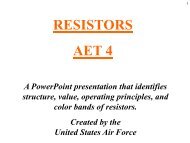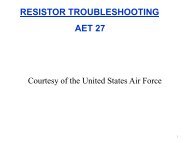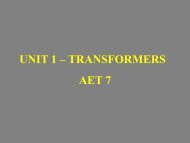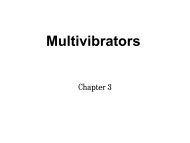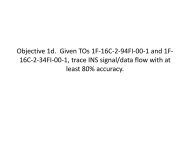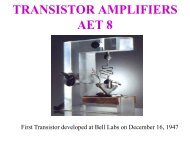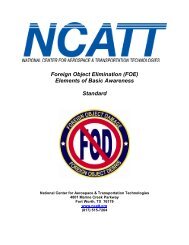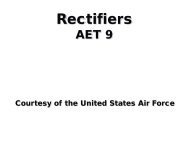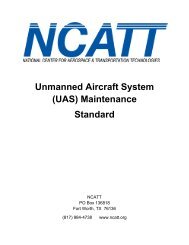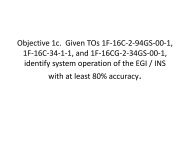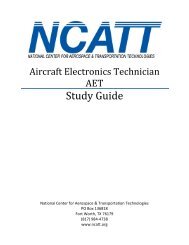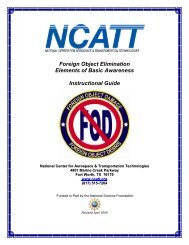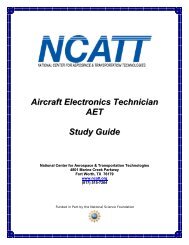(AET) Study Guide - NCATT
(AET) Study Guide - NCATT
(AET) Study Guide - NCATT
- No tags were found...
You also want an ePaper? Increase the reach of your titles
YUMPU automatically turns print PDFs into web optimized ePapers that Google loves.
Page 17 of 51germanium or silicon, these materials are capable of carrying current and becomingsemiconductors.• Forward bias—Semiconductor condition of operation in which a low-resistant stateexists. On average, it takes about 0.7 VDC of the correct polarity applied to a diode tocause the diode to conduct. This action is known as forward biasing the diode.• Reverse bias—Semiconductor condition of operation in which a high-resistance stateexists. If voltage is applied in the reverse direction to a diode, the diode will not supportthe conduction of electricity.• Insulator— See Basic Terms/Direct Current (DC).• Diode—Simplest electrical semiconductor device formed when an N-type material isjoined with a P-type material. Diodes are commonly used to change AC electricity intoDC electricity (rectification). Diodes allow current to flow in one direction only.• Full-wave Rectifier—Commonly used to change AC electricity into DC electricity.Output DC voltage is ½ of the input AC voltage.• Half-wave Rectifier—Commonly used to change AC electricity into DC electricity.Output DC voltage is pulsating with ½ the frequency of the input AC voltage.• Three-phase Rectifier—Commonly used to change AC electricity into DC electricity.Output DC voltage is the same as the input AC voltage.• Ripple amplitude—Frequency of a ripple in the output of a rectifier circuit.9. Power Supply Circuits <strong>NCATT</strong> Training Standard Level (A)(b) FiltersObjective:Identify basic facts and terms about power supply circuit filters to include active filters andpassive filters.Content – Power Supply Circuit Filters:Explain the use and operation of power supply circuit filters with reference to the followingterms:• Active filters—Produces a current or voltage gain.• Passive filters—Produces no gain in an electrical circuit.10. Frequency Sensitive Filters <strong>NCATT</strong> Training Standards Level (A)Theory of OperationObjective:Identify basic facts and terms about the theory of operation for frequency sensitive filters.Content – Theory of Operation:Explain the use and operation of frequency sensitive filters with reference to the following terms:• Filtering—Frequency-sensitive filter circuits are designed to pass a certain range offrequencies from the generator to the load device and reject all other frequencies. Filtersare placed between the signal source (generator) and the load device. These filters act asfrequency sensitive voltage dividers.Copyright © 2008 by the National Center for Aircraft Technician Training. All rights reserved.Individuals may download, print, and make copies of this documentfor their own personal use. Commercial use prohibited.



